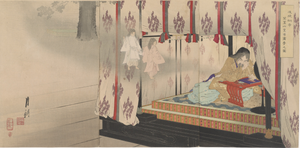| Siege of Kasagi | |||||||
|---|---|---|---|---|---|---|---|
| Part of Genkō War | |||||||
 Woodblock print triptych by Ogata Gekkō. Emperor Go-Daigo dreams of ghosts at Kasagiyama. | |||||||
| |||||||
| Belligerents | |||||||
| Temple garrison | Hōjō clan forces | ||||||
| Commanders and leaders | |||||||
| Emperor Go-Daigo | Ashikaga Takauji | ||||||
| Strength | |||||||
| 3,000 | 75,000 | ||||||
| Genkō War | |
|---|---|
The 1331 siege of Kasagi was among the first battles of the Genkō War, which brought an end to Japan's Kamakura period. Emperor Go-Daigo, who had been plotting against the shogunate and the Hōjō clan regents, had hidden the Japanese imperial regalia in Kasagi-dera, a fortified Buddhist temple, atop Kasagiyama, just outside Kyoto, and was secretly raising an army from there.
The temple was raided in the night by Hōjō forces under Suyama Yoshitaka and Komiyama Jirō, who climbed the cliffs surrounding the fortress, and set it aflame. The Emperor, however, escaped and fled.
The temple was rebuilt in 1381, and destroyed by fire again less than twenty years later. Today, only a few buildings remain.
References
- ^ Sansom, George (1961). A History of Japan, 1334-1615. Stanford University Press. p. 9. ISBN 0804705259.
- Turnbull, Stephen (1998). The Samurai Sourcebook. Cassell & Co. p. 206. ISBN 1-85409-523-4.
- Frederic, Louis (2002). "Japan Encyclopedia." Cambridge, Massachusetts: Harvard University Press.